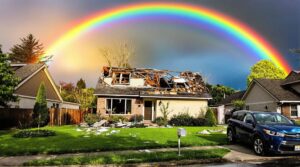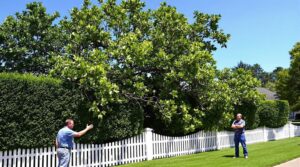When a car hits a fence, the party responsible for paying for the damage is typically the driver or owner of the vehicle. In cases where the driver is uninsured or cannot be identified, the homeowner's insurance policy may provide coverage for the damages. To establish liability, gathering evidence such as witness statements, photographs, and surveillance footage is essential. By understanding the process of determining responsibility and collecting evidence, homeowners can better navigate the situation and explore options for compensation.
Key Takeaways
- Liability for fence damage typically falls on the driver's insurance, but hit-and-run cases may involve homeowners insurance coverage.
- Identifying the driver and vehicle, along with collecting evidence, is crucial for establishing liability and securing compensation.
- A police report is essential for insurance claims and potential lawsuits, especially if property damage exceeds a certain threshold.
- Insurance companies assess claims based on evidence, and understanding deductibles and policy limits is important for compensation.
- If insurance claims do not adequately compensate for damages, pursuing legal action may be necessary to establish negligence and seek fair compensation.
Determining Responsibility for Fence Damage
When a vehicle collides with a fence, determining responsibility for the damage is vital in establishing liability and pursuing compensation. In such cases, homeowners insurance policies typically cover damages to fences resulting from hit-and-run incidents or vehicular accidents. However, the specific coverage depends on the policy details, which may vary considerably.
To establish liability, it is important to identify the driver and their vehicle, if possible. Witnesses, surveillance footage, and vehicle registration information can be essential in determining liability. The driver who caused the damage is legally responsible for the costs of fence repair.
Liability determination is a key step in pursuing compensation, as it enables homeowners to file insurance claims or civil lawsuits against the driver. A thorough investigation and documentation of the incident are necessary to guarantee accurate liability determination and successful pursuit of compensation for fence repair costs. Working with public adjusters can increase settlement amounts by 30-50% when filing insurance claims for property damage.
Essential Steps for Gathering Evidence
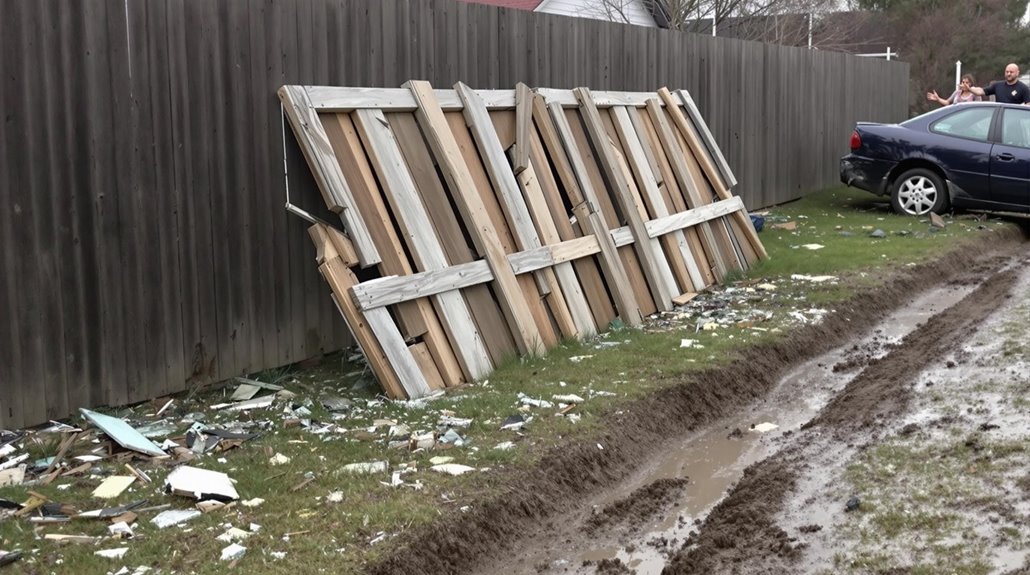
Establishing liability for fence damage caused by a vehicle collision relies heavily on the quality of evidence collected from the scene. To guarantee the best possible outcome, critical steps must be taken for gathering evidence.
Evidence documentation is key, as it provides a tangible record of the incident. Taking high-resolution photographs and videos of the damage, vehicle debris, and tire marks is essential, as is capturing video surveillance footage, if available.
Witness cooperation is also important, as witness statements can corroborate the incident's accounts and provide an impartial perspective. Witness contact information should be collected promptly to aid in identifying the hit-and-run driver.
Additionally, physical evidence, such as vehicle parts or debris, should be collected and retained, and any communication with the perpetrator should be documented.
Reporting the Incident to the Authorities
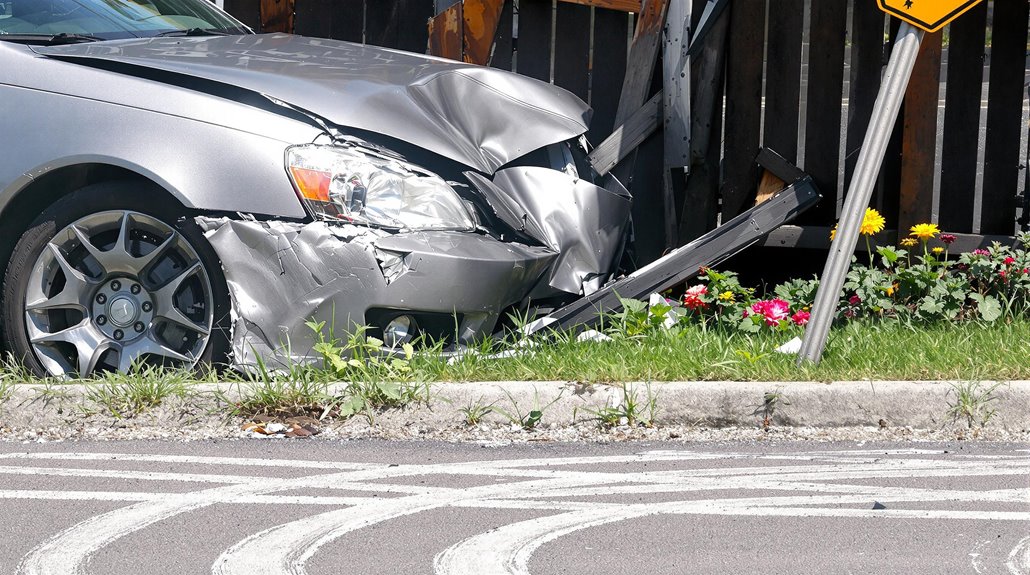
How should damage to a fence caused by a vehicle collision be reported to the authorities? Reporting methods include filing online, calling the police to the scene, or in-person reporting at a local police station.
In North Carolina, for instance, accidents must be reported under specific circumstances such as injury, death, or property damage exceeding $1,000. Contacting local law enforcement immediately allows for the creation of an official record, which is essential for insurance claims and potential lawsuits.
Police involvement plays an important role in the reporting process. Reporting triggers an immediate investigation, increasing the chances of apprehending the culprit, particularly in hit-and-run situations.
A police report serves as official documentation of the incident, providing significant details that may aid in the investigation and support insurance claims. Filing a police report is recommended for claiming compensation.
Providing accurate details and avoiding speculation guarantees a thorough report.
Navigating the Insurance Claims Process
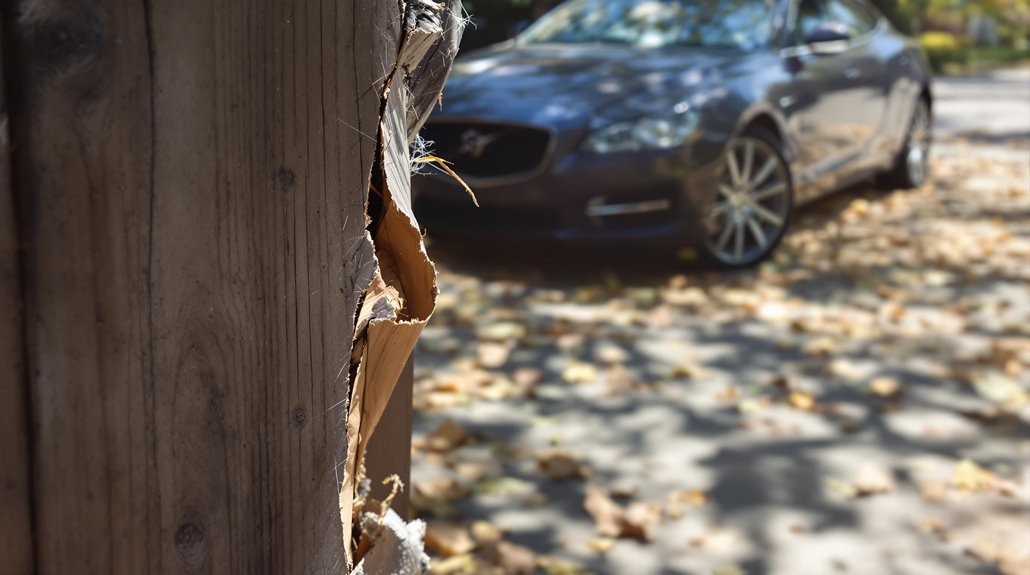
Following the creation of an official record with the authorities, the next step in resolving a fence damage claim is to navigate the insurance claims process. This involves an insurance policy evaluation to determine the extent of coverage for the damage.
Homeowners should review their policy terms, including coverage limits and exclusions, to understand what is covered and what is not.
The claims processing timeline typically begins with notifying the insurance company and providing documentation of the damage, such as photos and repair estimates.
The insurance company will then assess the claim and determine the amount of coverage available. If the claim is approved, the insurance company will issue payment for the repairs.
Homeowners should be aware of the deductible and any applicable policy limits, as these can impact the amount of coverage available.
A thorough understanding of the insurance claims process is essential to guarantee a smooth and efficient resolution.
Working with public adjusters can increase settlement amounts by 30-50% for property damage claims.
Pursuing Compensation Through Legal Action
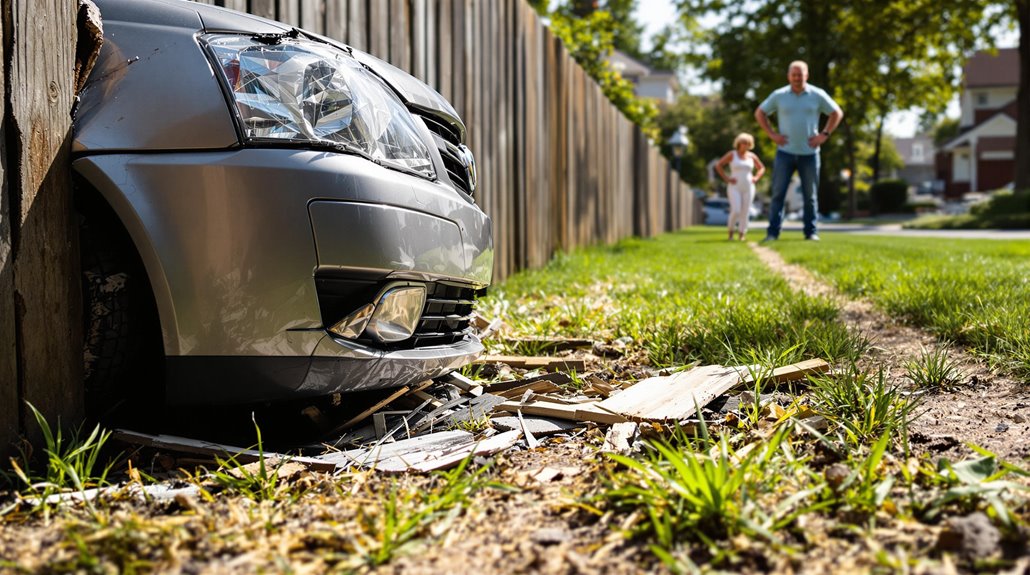
When the insurance claims process is unsuccessful or insufficient in providing adequate compensation for damages, homeowners may need to contemplate pursuing compensation through legal action against the responsible party.
This course of action involves various steps, including filing a claim in the appropriate court and presenting evidence to support the case.
Key considerations for pursuing compensation through legal action include:
- Evaluating the feasibility of the case, including the defendant's ability to pay any judgment
- Establishing the legal elements of negligence, such as duty, breach, causation, and damages
- Filing and serving the summons and complaint properly
- Detailing the facts, liability, and damages in the complaint
- Understanding the statute of limitations for property damage claims in the relevant jurisdiction
Homeowners should be aware that legal proceedings can be complex and time-consuming, and may involve additional costs.
However, pursuing compensation through legal action can provide a means of securing fair compensation for damages.
Working with an experienced attorney who charges a 30-40% contingency fee can help navigate the complexities of legal proceedings while avoiding upfront costs.
The Benefits Of Consulting A Public Adjuster

Consulting a public adjuster following a fence damage incident can bring expertise in insurance claims, enabling homeowners to navigate the often complex process of pursuing compensation.
An objective damage assessment by a public adjuster guarantees that the extent of the damage is accurately documented, forming the basis of a credible claim.
This streamlined claim process ultimately contributes to higher claim payouts and settlements, making public adjusters a valuable resource in the aftermath of a damaging incident.
Claims handled by public adjusters have shown 800% higher settlements compared to those without professional representation.
Expertise In Insurance Claims
Leveraging the expertise of a public adjuster can substantially enhance the outcome of an insurance claim. Public adjusters possess in-depth knowledge of insurance policies and procedures, allowing for accurate coverage interpretation.
This expertise enables them to identify coverages that might be missed by policyholders and provide effective claims advocacy.
With bi-annual license audits ensuring their qualifications remain current, public adjusters maintain the highest professional standards in the industry.
- Knowledge of insurance policies and procedures to guarantee accurate coverage interpretation
- Ability to identify hidden coverages and provide effective claims advocacy
- Detailed documentation and paperwork assistance to present claims thoroughly
- Skilled negotiation with insurance companies to secure fair settlements
- Assistance in organizing necessary paperwork to facilitate a smooth claims process
Objective Damage Assessment
A thorough understanding of insurance policies and procedures is essential for effective claims advocacy, but it is equally important to establish a clear picture of the damages sustained.
In this context, an objective damage assessment plays a significant role in determining the scope and extent of the damage. Conducted by licensed adjusters, this assessment involves a detailed evaluation of the damage, including photographs, videos, and written reports.
Consulting a public adjuster can guarantee a fair and objective evaluation of damages. Public adjusters have extensive experience with various types of damage claims and can effectively document and present damages to insurance companies.
This facilitates the settlement process and helps policyholders secure fair settlements, underscoring the importance of objective assessment and thorough damage documentation.
While insurance company adjusters protect insurer interests, public adjusters represent policyholders throughout the claims process to help maximize settlement outcomes.
Streamlined Claim Process
Maneuvering through the complexities of the insurance claims process can be a formidable task, particularly for those unfamiliar with the intricacies of insurance policies and procedures.
A streamlined claim process can alleviate much of this burden. Consulting a public adjuster is a viable solution for achieving an efficient claim resolution. They facilitate efficient communication and thorough claim documentation, allowing claimants to focus on other matters.
- Guarantee all necessary documentation is gathered and submitted
- Communicate with insurance companies on behalf of the claimant
- Provide detailed assessments to negotiate higher settlements
- Assist in understanding insurance policies and coverage
- Expedite the claim resolution process through diligent record-keeping and availability for adjusters
Studies show that working with public adjusters increases settlements by 20-50% compared to handling claims independently.
Higher Claim Payouts & Settlements
Consulting a public adjuster not only facilitates an efficient claim resolution process, as previously discussed, but also greatly influences the outcome of insurance claims regarding higher claim payouts and settlements.
Public adjusters possess expert knowledge and experience in insurance policy expertise, accurate damage assessment, and proven negotiation skills. This enables them to secure higher payouts through effective claim negotiation.
By identifying overlooked coverage details and providing detailed reports, public adjusters guarantee that no covered damage is underestimated. As a result, claims handled by public adjusters often result in higher settlements compared to those handled by property owners alone.
Their contingency-based work motivates them to secure the largest settlement possible, ultimately benefiting the property owner. This expertise is invaluable in maximizing insurance payouts.
While they typically charge up to 10% commission of the final settlement amount, public adjusters' ability to secure substantially higher payouts often justifies their fees.
About The Public Claims Adjusters Network (PCAN)
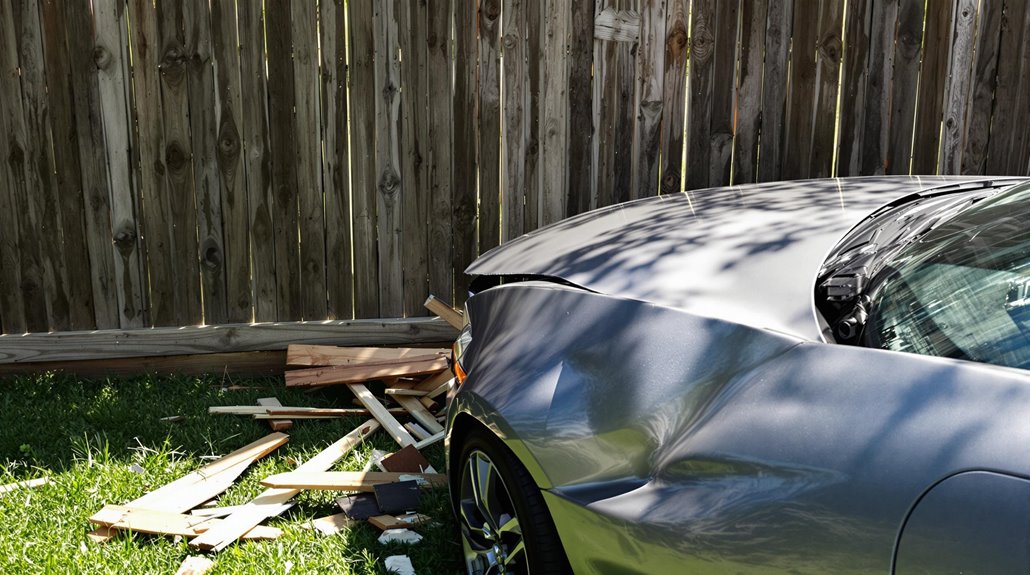
When maneuvering through complex insurance claims, policyholders often require expert guidance to ascertain fair settlements. The Public Claims Adjusters Network (PCAN) plays a crucial role in providing this expertise.
As a network of state-licensed insurance professionals, PCAN offers claim advocacy services to policyholders.
Some key benefits of working with PCAN's public adjusters include:
- Independently licensed and hired by policyholders to guarantee unbiased representation
- Expertise in insurance policies, damage assessment, and negotiation
- All-encompassing services, including claim filing and negotiation
- Ability to secure higher payouts compared to initial insurance company offers
- Personalized solutions tailored to each claim's unique needs
Members maintain professional standards through harmonious relationships with clients, insurers, and fellow adjusters while providing regular claim updates.
References
- https://www.freeadvice.com/legal/my-neighbors-tenant-crashe-251284/
- https://files.znu.edu.ua/files/Bibliobooks/Inshi77/0057184.pdf
- https://www.blgwins.com/someone-hit-my-fence-and-drove-away/
- https://wac.colostate.edu/docs/books/writingspaces1/writing-spaces-readings-on-writing-vol-1.pdf
- https://answers.justia.com/question/2018/07/13/can-i-be-held-liable-if-someone-wrecks-t-442794
- https://fencemakeovers.com/hits-my-fence-with-their-car/
- https://www.kannlawoffice.com/hit-and-run
- https://www.fs.usda.gov/sites/default/files/fire-management-today/76-2_0.pdf
- https://www.victimslawyer.com/practice-areas/personal-injury/premises-liability/gate-or-fence-accident/
- https://www.178wing.ang.af.mil/Portals/69/documents/afh33-337.pdf?ver=2016-12-15-101008-313

